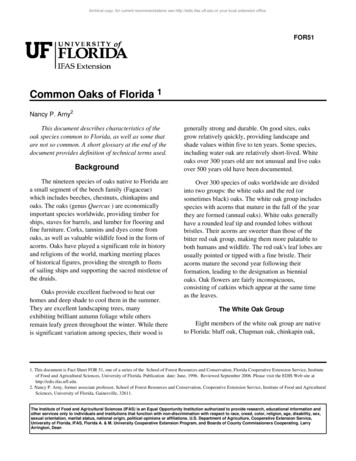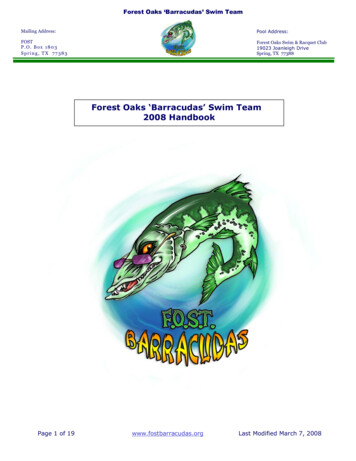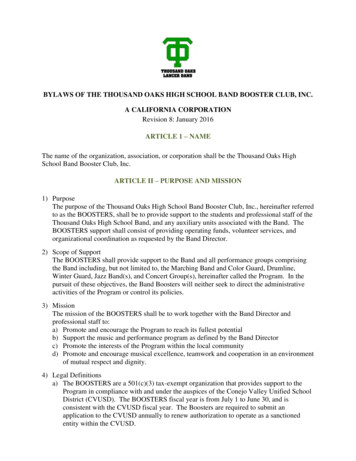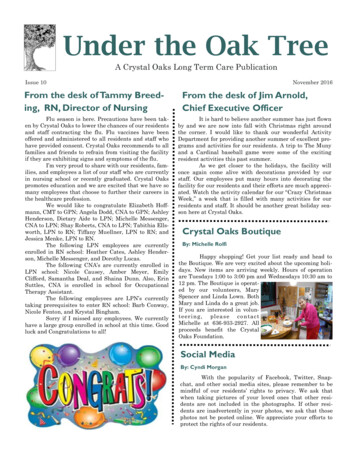
Transcription
Archival copy: for current recommendations see http://edis.ifas.ufl.edu or your local extension office.FOR51Common Oaks of Florida 1Nancy P. Arny2This document describes characteristics of theoak species common to Florida, as well as some thatare not so common. A short glossary at the end of thedocument provides definition of technical terms used.BackgroundThe nineteen species of oaks native to Florida area small segment of the beech family (Fagaceae)which includes beeches, chestnuts, chinkapins andoaks. The oaks (genus Quercus ) are economicallyimportant species worldwide, providing timber forships, staves for barrels, and lumber for flooring andfine furniture. Corks, tannins and dyes come fromoaks, as well as valuable wildlife food in the form ofacorns. Oaks have played a significant role in historyand religions of the world, marking meeting placesof historical figures, providing the strength to fleetsof sailing ships and supporting the sacred mistletoe ofthe druids.Oaks provide excellent fuelwood to heat ourhomes and deep shade to cool them in the summer.They are excellent landscaping trees, manyexhibiting brilliant autumn foliage while othersremain leafy green throughout the winter. While thereis significant variation among species, their wood isgenerally strong and durable. On good sites, oaksgrow relatively quickly, providing landscape andshade values within five to ten years. Some species,including water oak are relatively short-lived. Whiteoaks over 300 years old are not unusual and live oaksover 500 years old have been documented.Over 300 species of oaks worldwide are dividedinto two groups: the white oaks and the red (orsometimes black) oaks. The white oak group includesspecies with acorns that mature in the fall of the yearthey are formed (annual oaks). White oaks generallyhave a rounded leaf tip and rounded lobes withoutbristles. Their acorns are sweeter than those of thebitter red oak group, making them more palatable toboth humans and wildlife. The red oak's leaf lobes areusually pointed or tipped with a fine bristle. Theiracorns mature the second year following theirformation, leading to the designation as biennialoaks. Oak flowers are fairly inconspicuous,consisting of catkins which appear at the same timeas the leaves.The White Oak GroupEight members of the white oak group are nativeto Florida: bluff oak, Chapman oak, chinkapin oak,1. This document is Fact Sheet FOR 51, one of a series of the School of Forest Resources and Conservation, Florida Cooperative Extension Service, Instituteof Food and Agricultural Sciences, University of Florida. Publication date: June, 1996. Reviewed September 2006. Please visit the EDIS Web site athttp://edis.ifas.ufl.edu.2. Nancy P. Arny, former associate professor, School of Forest Resources and Conservation, Cooperative Extension Service, Institute of Food and AgriculturalSciences, University of Florida, Gainesville, 32611.The Institute of Food and Agricultural Sciences (IFAS) is an Equal Opportunity Institution authorized to provide research, educational information andother services only to individuals and institutions that function with non-discrimination with respect to race, creed, color, religion, age, disability, sex,sexual orientation, marital status, national origin, political opinions or affiliations. U.S. Department of Agriculture, Cooperative Extension Service,University of Florida, IFAS, Florida A. & M. University Cooperative Extension Program, and Boards of County Commissioners Cooperating. LarryArrington, Dean
Archival copy: for current recommendations see http://edis.ifas.ufl.edu or your local extension office.Common Oaks of Florida2live oak, overcup oak, post oak, swamp chestnut oakand white oak. Sand post oak, a variety of post oak,also is native to Florida. All have alternately arrangedleaves, usually with rounded tips. The inner surfaceof the acorn shell is smooth and the relatively sweetacorns of white oaks generally germinate in the fallof the year.Bluff Oak ( Quercus austrina )Bluff oak ( Figure 1 ) is similar to white oak butgenerally smaller. As its name implies, bluff oak canbe found on riverside bluffs in moist, rich soils. Itsleaves are 3-to-8-inches long, usually with five short,rounded lobes; dark green above and lighterunderneath. Oval acorns appear singly or in pairs andmay be slightly fuzzy near the apex or tip. The cupcovers a third to a half of the nut.Figure 2 .and round-topped and the tree may resemble a shrubin the northern part of its range.Figure 3 .Figure 1 .Bluff oaks have little economic significance butcontribute to species diversity of forested areas andprovide valuable wildlife food and nesting sites.Chapman Oak ( Quercus chapmanii )While Chapman oaks ( Figure 2 ) may reach 50feet in height and exceed 10 or 12 inch diameters,Florida specimens rarely grow beyond shrub heightin the dry, sandy scrub ecosystem they inhabit. Thisoak's narrow, unlobed leaves are silvery green withshort, hairy petioles. They are about 3-1/2-incheslong. The knobby, warty cups of Chapman acornscover almost one half of the fruit. Acorns occursingly or in pairs.Chinkapin Oak ( Quercus muehlenbergii )The chinkapin oak ( Figure 3 ) is found on dry,rocky soil and limestone ridges in the northern U.S.and in deep, rich, valley soil in association with otherhardwoods in the southern U.S. It is commonthroughout the eastern U.S. except on the coastalplain. Chinkapins may reach heights from 60 to 80feet and diameters of 2 to 3 feet. Crowns are narrowLeaves are alternate, simple and deciduous, 4-to7-inches long and 1-to-4-inches wide. The leaf iswedge-shaped, silvery and pubescent below with astout yellow midrib. Acorns generally appear singlyon the reddish-purple twigs. Pairs do occur. Barkbecomes grey as it matures. Acorns aredark-brown-to-black, measuring 3/4-inch in length. Abowl-shaped cap with brown scales covers half of thefruit.Live Oak ( Quercus virginiana )Majestic, moss-draped live oaks ( Figure 4 )reach heights of 40 to 50 feet with trunk diameters of3-to-4 feet. Their low, massive branches providednaturally formed, angled wood valuable in buildingthe wooden ships of the 1800s. It was for this reasonthat one of America's first forest reserves wasestablished in the panhandle of Florida. Live oaks arecommon on sandy soils throughout the state. Theirrange along the coastal plain extends from Virginiato Texas.Unlike most other oaks, the live oak retains itsleaves until after the following year's leaves haveappeared. This habit results in an "evergreen" tree.Leaves are unlobed and rarely toothed: lustrous green
Archival copy: for current recommendations see http://edis.ifas.ufl.edu or your local extension office.Common Oaks of Florida3The deciduous leaves are 6-to-10-inches longand 1-to-4-inches wide with 5 to 9 lobes. The tip maybe pointed or round, but the base is alwayswedge-shaped. One inch long petioles are slender andsupport the dark green leaves with pale-pubescent ornearly smooth undersides. Acorns, in pairs or singly,are closely attached to twigs.Figure 4 .Post Oak ( Quercus stellata )above and pale-pubescent on the underside. Leaflength varies from 2-to-5 inches with width rangingfrom 1/2-to-2-1/2 inches.Acorns, usually in clusters of three to five, areset on relatively long stalks. The 1-inch long,brownish-black fruit is longer than it is round withalmost a third of its length covered by a top-shapedcap. Twigs are gray-brown and smooth. Mature barkis deep red-brown and slightly furrowed with smallsurface scales. Live oaks are among the morelong-lived oaks, frequently achieving ages greaterthan 200 years.A classic post oak leaf ( Figure 6 ) resembles across. The two central lobes of the five on each leafare larger and somewhat square. Size varies from 3 to4 inches in width and 4 to 5 inches in length. Leavesare dark green, covered with short, fine, soft hairs ontop. Leaves are wooly underneath.Overcup Oak ( Quercus lyrata )As its name implies, the scales of the cap, or cup,almost entirely enclose the 1/2-to-1-inch-round fruit.Overcup oaks ( Figure 5 ) may--in rare instances-achieve heights of 100 feet, but are generally shorter.Trees are frequently twisted and are of littleeconomic value, but provide valuable wildlife habitatin the bottomlands where they abound. They may befound with willows, swamp-chestnut oaks and elmsalong the coastal plain from New Jersey to Floridaand Texas. Their buttressed bases are an adaptation tothe wet soils of the bottomlands. Their gray-brownbark is irregularly ridged or flattened and may appearto spiral around the trunk.Figure 6 .Acorns, singly or in pairs, are closely attached tostout, somewhat fuzzy, brown twigs. They are about3/4-inch long with slight stripes running toward theirsomewhat fuzzy tips. The bowl-shaped cup coversabout a third of the nut.Post oak bark is thick and gray: blocky or scalyin youth, deeply fissured with plate-like scales atmaturity. This species can be found as far north asMassachusetts and as far west as Iowa and Texas. Avaluable timber species, post oak grows on dry, sandysoils or rocky slopes. Occasionally, it appears in richbottomlands.The sand post oak ( Quercus stellata var.margaretta ) also occurs in Florida. Generally smallerand scrubby, it has smaller leaves and more woolytwigs. The state champion sand post oak grows inGainesville.Figure 5 .
Archival copy: for current recommendations see http://edis.ifas.ufl.edu or your local extension office.Common Oaks of Florida4Swamp Chestnut Oak ( Quercus michauxii )Also known as basket oak or cow oak, this60-to-80-foot-tall swamp chestnut oak tree ( Figure 7) is found on moist, periodically flooded, bottomlandsoils from southern New Jersey to northern Florida.Its uses include traditional farming tools, baskets,posts, and barrels. Margins of the unlobed deciduousleaves have coarse, wavy teeth. The leaf is5-to-8-inches long and 3-to-4-inches wide; darklustrous green on top, silvery pubescent below.Figure 8 .Bark of the white oak is light gray: in scalyrectangles when young--becoming ridged andshallowly fissured at maturity. Trees may achieveheights of 80-to-150 feet with diameters up to 5 feeton rich soils, sandy soil, and stony ridges.The Red Oak GroupFigure 7 .Solitary or paired lustrous brown acorns are1-to-1-1/2-inches long with a bowl shaped cup ofwedge-shaped scales covering a third of its length.Stout, red-brown twigs mature to a brownish gray,while bark of the mature tree is a furrowed, scalygray outside and red inside.White Oak ( Quercus alba )This model for the white oak group ( Figure 8 )exhibits 7-to-9-rounded lobes with sinuses angledtoward the usually three-lobed tip. Extending from a1-inch petiole, a yellow midrib runs the full5-to-9-inch length of each bright green leaf. Two to 4inches wide, the leaf's underside is pale. Acorns,solitary or in pairs, are almost directly attached topale-to-gray twigs. The light brown 3/4-inch long nutshows three-fourths of its length beyond thebowl-shaped cap.White oak timber is valuable for ship building,furniture, barrels, baskets, and fuel. White oak acorns,a valuable wildlife food, were once widely used byNative Americans after the acorns were boiled toremove the tannin. This resource is available fromsoutheastern Canada to mid-Florida and northwest toMinnesota.Eleven members of the red oak group are nativeto Florida. As mentioned earlier, all exhibit alternateleaves, pointed and/or bristle-tipped leaves and acornswhich take two years to mature. The acorns of redoaks are generally bitter to the taste and frequentlyexhibit wooly or silky inner linings in a tough outershell. These seeds generally germinate (sprout) in thespring.Black Oak ( Quercus velutina )Black oaks ( Figure 9 ) reach heights between 70and 85 feet with trunk diameters of 3 to 4 feet. Thelow, wide, spreading crown exhibited by open-growntrees is composed of branches and leaves dark greenabove and copper-green below. Leaves are generallywedge-shaped, with variable margins. The 5-to-7broad or narrow lobes are sometimes separated bydeep sinuses; sometimes by very shallow ones. Lobesand tip invariably display bristles. Petioles are long(3 to 5 inches) and stout. Tufts of hair are usuallyvisible in the axils of veins on the underside of theleaf.Acorns are variable as well--sometimes oval,sometimes nearly hemispherical. Bark isreddish-brown on young twigs. The trunk bark is darkbrown and smooth with an orange-red inner bark inyouth. As trees mature, bark becomes thick and scalywith deep vertical furrows.
Archival copy: for current recommendations see http://edis.ifas.ufl.edu or your local extension office.Common Oaks of Florida5Blackjack oaks may be found on dry, sandy soilsfrom New York and southern Michigan, west toTexas and south to Florida.Bluejack Oak ( Quercus incana ) [FormerlyQuercus cinerea ]Figure 9 .Growing from southern Maine to Florida andTexas, black oaks may be found on dry slopes andridges or moist, rich soils. It is rare in bottomlands.Leaves do not turn vivid colors in autumn, so thisspecies is rarely planted as an ornamental. Its wood isvaluable and the bark is a major source of tannic acidand a yellow dye called quercitron.The bluejack oak ( Figure 11 ), is a small tree orlarge shrub seldom exceeding heights of 30 to 35 feet.Diameters of 5 to 10 inches are normal. Suchdiminutive size is not surprising considering the sitespreferred are dry, sterile, sandy soils from Virginia toEast Texas and south to peninsular Florida. It is acommon associate of turkey oak and longleaf pine.Blackjack Oak ( Quercus marilandica )The blackjack oak ( Figure 10 ) is a small tree,rarely exceeding 50 feet in height, occasionally usedfor posts, ties or fuelwood. Average heights are 20 to30 feet with diameters approaching 12 inches. Thecrown of this species is frequently narrow andcontorted and its bark is black, divided intoblock-like plates.Figure 11 .The unlobed (rarely 1-to-4 lobes)oblong-oblanceolate leaves are blue-green withwooly lower surfaces. They range from 2 1/2 to 5inches in length and up to 2 inches in width. Leaveson sprouts may be irregularly dentate. The leaf tipmay be rounded or blunt with a short bristle.Acorns of the bluejack oak are nearly globularand are characterized by hairs near the apex andlongitudinal striations. They are light brown with palepubescent scales covering about half of the nut.Figure 10 .Leaves of the blackjack are deciduous; darkyellow-green above and orange-pubescent below.Size varies from 2 to 3 inches in width and 6 to 7inches in length. The leaf shape is quite variable: theyare broadly ovate with 3 (rarely 5) bristle-tippedlobes. The overall pattern of the leaf is a T, narrow atthe base and broadest at, or very near, the tip. Thebase is roundly wedge-shaped.The light-brown acorns are oblong to ovoid,about 3/4 inch long. About half the nut is covered byloose, reddish-brown scales of the cap.Laurel Oak ( Quercus laurifolia )The medium-sized laurel oak tree ( Figure 12 )usually reaches heights of 50 to 60 feet, though treesas tall as 100 feet have been recorded. Diameters of 3to 4 feet are normal.Slender branches form a broad, round-topped,dense crown. Laurel oaks are found scattered onsandy soils near streams and swamps from the coastalplain of North Carolina to central Florida.Leaves are simple and deciduous, although theyremain on the tree through much of the winter,
Archival copy: for current recommendations see http://edis.ifas.ufl.edu or your local extension office.Common Oaks of Florida6The 1-to-2-inch-long leaves are oval to oblong,leathery and sometimes bristle-tipped. Margins areentire and both surfaces are smooth, dark green andshiny. Twigs are hairy and acorns are very small,about 1/2 inch in diameter, and round. Asaucer-like-to-top-shaped cup of small, flattenedscales encloses about half of the nut. Acorns grow inpairs or clusters.Figure 12 .generally falling in early spring. The tree will remainbare of leaves for several weeks before the newoblong leaves appear. They are 2 to 4 inches long atmaturity, and 1/2 to 1 inch wide. Margins are eitherentire or irregularly lobed. Laurel oak leaves arelustrous green above and pale below with a yellowmid-rib.Acorns are generally solitary, commonlysubsessile and egg-shaped. The 1/2-inch-long nut isbrownish-black, covered by a thin, saucer-shaped capwith reddish-brown pubescent scales. Twigs areslender and deep red. Mature bark is up to 1/2 thickand dark reddish-brown: at first smooth, thenbecoming divided into deep fissures separated bybroad, flat ridges.Although of no commercial value for woodproducts, the dense thickets provide protection forboth wildlife and sand dunes, as well as enhancingthe visual aspect of many coastal communities.Shumard Oak ( Quercus shumardii )From Maryland on the East Coast to Iowa andTexas in the West, the Shumard oak ( Figure 14 )ranges as far south as central Florida. It is a large,attractive tree, attaining height of 90 to 125 feet onideal sites in deep, rich bottomlands along streamsand riverbanks.Myrtle Oak ( Quercus myrtifolia )This small, evergreen oak is commonly found incoastal areas on sandy ridges from South Carolina toMississippi--including peninsular Florida. Thickforests of wind-sculptured myrtle oaks ( Figure 13 )are common along seashores where development hasnot yet occurred. It is a small tree, seldom reachingover 35 feet in height with diameters generally from4 to 8 inches. The bark is light gray and smooth,becoming shallowly furrowed and ridged andwrinkled at joints where the trunk bends.Figure 14 .Leaves of the Shumard are alternate, simple anddeciduous in habit; obovate in shape. They are 6 to 8inches long and 4 to 5 inches wide, with awedge-shaped or flattened base. Six to 11bristle-tipped lobes on each leaf are dark green aboveand paler green below with tufts of hairs where veinsand mid-ribs meet. Sinuses are rounded and generallydeep.This commonly planted landscape tree hasmoderately stout, hairless, gray-brown twigs. Maturebark is thick with whitish, scaly ridges separated bydark fissures. The foliage of Shumard oaks turns adeep crimson red in autumn; one reason it is valuedas an ornamental.Figure 13 .
Archival copy: for current recommendations see http://edis.ifas.ufl.edu or your local extension office.Common Oaks of FloridaIts acorns are oblong to ovoid, up to 1-1/4 inch inlength and 1 inch in diameter. The cap issaucer-shaped with somewhat pubescent scales.Southern Red Oak ( Quercus falcata )A valuable commercial species, the southern redoak ( Figure 15 ) may reach heights of 70 to 80 feet.Diameters of 2 to 3 feet are normal. Spreadingbranches create a broad, open, round-topped crown.Southern red oak can be found on dry, infertile soil instands of mixed hardwoods and pine from NewJersey and southern Illinois in the North to Texas andcentral Florida in the South.7var. pagodaefolia . It is a common bottomlandspecies of the southern coastal plain and theMississippi River Valley. The largest specimens arefound on moist, loamy ridges, old fields, and flats.Trees may reach heights of 100 to 130 feet and attaindiameters of 3 to 5 feet.Figure 16 .Leaves are 5- to 11-lobed. They closely resemblesouthern red oak leaves, but have more lobes. Bark ofmature trees is gray-black flaky or scaly somewhatresembling the bark of a cherry tree. Acorns areabout 1/2-inch long, round or hemispherical with athin, shallow cap covering up to a third of the nut.Figure 15 .Leaves are deciduous, 5 to 9 inches in length and4 to 5 inches in width. The base is definitelybell-shaped at the junction of the flattened 1-to-2 inchpetiole. Upper surface of the leaf is lustrous darkgreen and the underside is rusty and pubescent. Twobasic leaf shapes are common: 1) obovate with threebristle-tipped apical lobes or 2) 5 to 7 deeply dividedlobes with a long, often subdivided terminal lobe.Acorns appear singly or in pairs. They are nearlyround, 1/2-inch long, and orange-brown. The capmay be shallow and bowl-like or top-shaped ,covering a third to a half of the nut. Cup scales arepale pubescent except on the margins. The acorn isattached to stout twigs which are orange andpubescent in their first year, becoming hairless anddark red their second year. Bark of the mature tree isup to 1-inch thick, with dark brown or black roughscaly ridges separated by deep fissures.Turkey Oak ( Quercus laevis )The leaves of this relatively small tree are thick,rigid and heavily veined, bright yellow-green lustrousabove and somewhat paler below. They are deeplydivided into 3 or five lobes. Rarely there are sevenlobes on a turkey oak leaf ( Figure 17 ). Lobes may betoothed and the tip is usually 3-toothed. Theunderside of the leaf may show tufts of rusty-redaxillary hairs. Petioles are generally twisted, allowingthe leaf to sit perpendicular to the ground, reducingsurface area exposed to the drying sunlight of itssandhill habitat.Swamp Red Oak ( Quercus pagoda )This valuable timber and wildlife species, theswamp red oak ( Figure 16 ) sometimes referred to ascherrybark oak, was once known as Quercus falcataFigure 17 .
Archival copy: for current recommendations see http://edis.ifas.ufl.edu or your local extension office.Common Oaks of FloridaTurkey oaks can be found in dry, sandy, sterilesoil. Common uses include fuel and construction onfarms. The form and size preclude use as commercialtimber. Maximum heights are generally 20 to 30 feet,with diameters of 2 feet. The crown is broad, open,and irregular.Acorns are light brown, about 1-inch long and3/4- inch wide. They are oval with rounded ends. Oneend is enclosed by a small, thin red-brown capcovered by scales.Water Oak ( Quercus nigra )The leaves of the water oak ( Figure 18 ), a tall,slender oak are semi-persistent, falling a few at a timethroughout the winter. This persistence may give theappearance of an evergreen habit, but leaves do notpersist into the second growing season. Water oaksare extremely variable in shape and size, especiallyon sprout growth. Even on mature branches, shapevaries widely. They are generally shaped like aspatula, narrow at the base and broadly rounded nearthe tip. Margins may be entire, three-lobed near thetip or variously lobed on both margins. Both surfacesof the leaf are green and smooth except for infrequentaxillary hairs below. The lower surface is a slightlylighter green.8This wide-spread species may be found in mixedpine-hardwood forests, along roadsides, in flatwoods,bottomlands or urban openings. Its range extendsalong the Atlantic and Gulf coasts to East Texas andsouth into central Florida.Willow Oak ( Quercus phellos )This frequently planted ornamental tree reaches80 to 130 feet in height with trunk diameters of 3-to-6feet. Grown in the open, the trunk is short with adense, broad oblong or oval crown covered withdeciduous leaves with bristle-tips. In forests, the treetends toward a longer trunk with a spherical crown.Preferred sites are rich, moist bottomlands alongswamps and streams. This oak is rare on drier sites.Leaves are 2 to 5 inches in length and 1/2 to 1inch in width and exhibit wavy or irregularly lobedmargins on sprout growth. Like the willow this oak isnamed for, its leaves are generally lanceolate, thoughsome specimens may be oblong ( Figure 19 ). Mostare broadest near the middle of the leaf. The uppersurface is light green, smooth and shiny with raisedveins. The lower surface is paler and may havewhitish hairs along the midrib. The thin petioles are1/4-inch long.Figure 19 .Figure 18 .Even large water oaks (50 to 70 feet in height isaverage) retain relatively smooth bark. It is smoothand brown in youth, grading to gray-brown withirregular furrows. Diameters of 2 to 3 feet arecommon for mature trees.Acorns are solitary or occasionally in pairs. Thelight-brown-to-nearly-black nuts are oval tohemispherical in shape and may be pubescent near thetip. They are about 1/2-inch long with a pubescent,saucer-shaped reddish-brown cup.Acorns may be solitary or in pairs, hemisphericaland 1/3-to-1/2-inch long. The nut is yellowish brownand bluntly pointed. The cup is greenish-brown, thinand saucer-shaped, enclosing only the base of the nut.GlossaryAlternate leaf arrangement. Leaves are off-seton each side of the twig (not opposite)Apex. The tip or point of a leaf or acorn
Archival copy: for current recommendations see http://edis.ifas.ufl.edu or your local extension office.Common Oaks of FloridaBase. The end of the leaf or acorn nearest thetwigCatkin. A flexible, often pendent, cluster ofunisexual flowers arranged along a central axisCap or cup. The scaly covering by which thenut (acorn) is attached to the twigCrown. The portion of a tree includingbranches, twigs and leavesDentate. Toothed or tooth-likeLanceolate. Shaped like a spear point; long andthinLobe. A part of a leaf which extends outwardfrom its general massMargin. The edge of the leafMidrib. The central vein or structure of a leafNut. Used here to mean the portion of an acorncontaining the seedOvate. Egg-shapedObovate. Shaped like an upside-down eggPetiole. The "stem" of a leaf, by which it isattached to a twigPubescent. Covered with soft, fine, short hairsSinus. The space (indentation) between lobes9
document provides definition of technical terms used. Background The nineteen species of oaks native to Florida are a small segment of the beech family (Fagaceae) which includes beeches, chestnuts, chinkapins and oaks. The oaks (genus Quercus ) are economically important species worldwide, providing timber for










